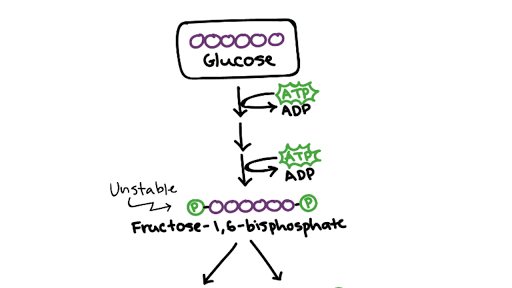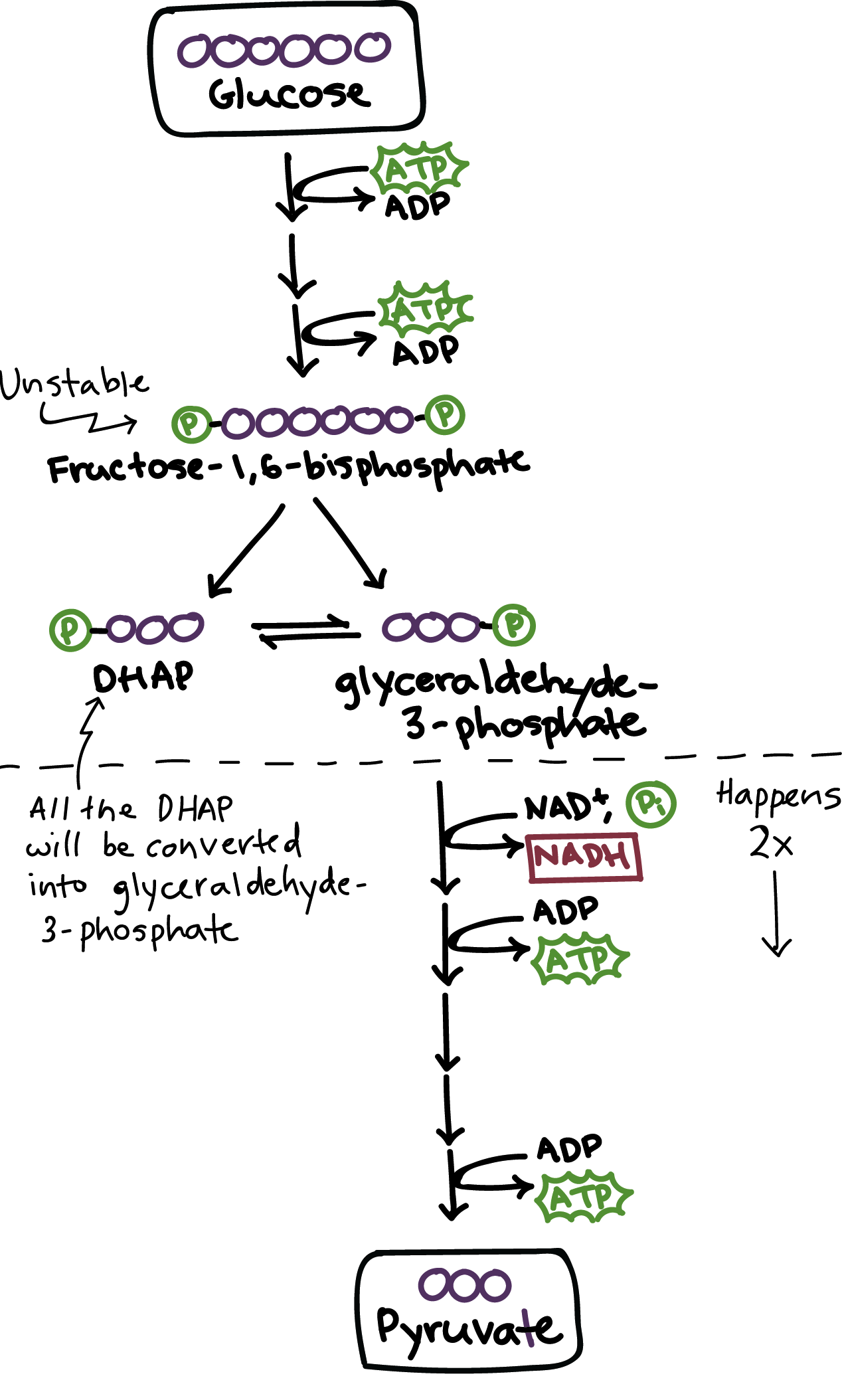Glycolysis Can Best Be Described as
A conversion of glucose into carbon dioxide and water. The energy-requiring phase above the dotted line in the image below and the energy-releasing phase below the dotted line.

Glycolysis Cellular Respiration Biology Article Khan Academy
It produces two molecules of pyruvate ATP NADH and water.

. Altered energy metabolism is a biochemical fingerprint of cancer cells that represents one of the hallmarks of cancer. Glycolysis is the first phase of cellular respiration. Glycolysis literally means Splitting Sugars.
C taking electrons from food and giving them to oxygen to. Get the daily question sent to your inbox. 51 Glycolysis is best defined as a catabolic reaction based upon the ________.
A conversion of glucose into carbon dioxide and water. D formation of sugar. Glycolysis is the process in which glucose is broken down to produce energy.
Glycolysis is best defined as a catabolic reaction based upon the _____ asked Oct 16 2015 in Anatomy Physiology by Regiside A conversion of glucose into two molecules of pyruvic acid. C Catabolic Reductive EXPLANATION- Glycolysis means the breakdown of sugar is a catabolic process i View the full answer Transcribed image text. Releases a hormone C.
B conversion of pyruvic acid into carbon dioxide and water. Another name for the process is the Embden-Meyerhof pathway in honor of the major contributors towards its discovery and understanding1. In glycolysis glucose a six carbon sugar is split into two molecules of a three-carbon sugar.
Glycolysis Glucose Catabolic Pathway. It occurs in both aerobic and anaerobic organisms. Glycolysis is the primary step of cellular respiration which occurs in all organisms.
Glycolysis is a sequence of ten reactions catalyzed by enzymes. Enter your email below and get the daily PCAT question sent straight to your inbox every morning. Cellular respiration can best be described as taking electrons from food and giving them to oxygen to make water and using the energy released to drive ATP formation.
Glycolysis or the glycolytic pathway may be described as the metabolic breakdown of glucose a 6 carbon sugar in order to release energy. D conversion of glucose into two molecules of pyruvic acid. Removal of NH3 is best described asdocx Removal of NH3 is best described as ____________.
The first five of the 10 metabolic reactions in sequence can be described as vitally investing energy in the form of ATP. C21C31 Glycolysis can best be described as which of the following kinds of pathways. Glycolysis is a metabolic pathway that.
Reductive anabolic reductive catabolic reductive catabolic oxidative ОО oxidative. The free energy released in this process is used to form the high-energy molecules adenosine triphosphate ATP and reduced nicotinamide adenine dinucleotide NADH. It takes place in the cytoplasm where associated enzymes and factors are located.
C formation of sugar. This process is anaerobic and therefore does not require energy. Glycolysis is the process in which glucose is broken down to produce energy.
B conversion of glucose into two molecules of pyruvic acid. Glycolysis takes place in the cytosol of a cell and it can be broken down into two main phases. Asked Aug 24 2019 in Anatomy Physiology by BioMan.
It produces two molecules of pyruvate ATP NADH and water. Catabolic and synthetic cGlycolytic and aerobic d. 1Cellular respiration can best be described as a using energy released from breaking high-energy covalent bonds in organic molecules to force ATP formation from ADP and phosphate.
This metabolic phenotype is characterized by preferential dependence on glycolysis the process of conversion of glucose into pyruvate followed by lactate production for energy production in an oxygen-independent manner. The process takes place in the cytoplasm of a cell and does not require oxygen. C conversion of pyruvic acid into carbon dioxide and water.
Glycolysis is the metabolic process in which glucose is split into two molecules of pyruvic acid 3-carbon molecule under aerobic conditions Login Study Materials. The heart has been estimated to consume 20-30 times its own weight in ATP each day and mitochondria comprise about 30 of the volume of a cardiomyocyte. Glycolysis is the metabolic pathway that converts glucose C 6 H 12 O 6 into pyruvic acid CH 3 COCOOH.
Glycolysis is the first step of cellular respiration during which glucose is modified to a 6-carbon sugar diphosphate and then split into two 3-carbon molecules. Glycolysis When a ligand binds to a G protein-linked receptor the G protein A. A using energy released from breaking high-energy covalent bonds in organic molecules to force ATP formation from ADP and phosphate taking electrons from food and giving them to phosphate to make ATP taking electrons from food and giving them to oxygen to make water using the energy released b c.
The process takes place in the cytoplasm of a cell and does not require oxygen. Anaerobic and catabolic b. The other five reactions produce a surplus in other words a profit is achieved which ensures that the process of glycolysis doesnt defeat the purpose of respiration which is to supply an organism with energy as there.
Glycolysis yields two molecules of ATP free energy containing molecule two molecules of Pyruvic acid and two high energy electron carrying molecules of NADH. Glycolysis is a metabolic pathway and an anaerobic energy source that has evolved in nearly all types of organisms. Binds to a signal molecule B.
Cellular respiration can best be described as. B taking electrons from food and giving them to phosphate to make ATP. Glycolysis is best defined as a catabolic reaction based upon the ________.
Before entering the Krebs cycle pyruvate is converted to. Glycolysis is best defined as the breakdown of. In this phase the starting molecule of glucose gets rearranged and two phosphate groups are.
Aerobic and catabolic eAnaerobic and anabolic. See Answer while the last half can be best Glycolysis can be divided into 2 halves the first half can be best described as described as oxidative. Which of the following statements about glycolysis is true.

Glycolysis Cellular Respiration Biology Article Khan Academy

Cell Respiration Wyzant Resources Cell Respiration Photosynthesis And Cellular Respiration Biology Classroom

The 7 Best Metabolism Boosting Breakfast Foods Drinks Carbohydrates Chart Protein Metabolism Metabolism

Glycolysis Biology For Majors I

Spmstraighta Teaching Biology Medical Laboratory Science Biology Classroom

This Graph Displays The Use Of Us Of Each Of The Energy Systems In Relation To Overall Performance You Can See As One Begins To Dec Metabolism Aerobics Energy

This Is A Simple Graphical Representation Of Glycolysis Which Is The First Step Of Cell Respiration Cell Respiration Biology Class Biology

Glycolysis Cellular Respiration Biology Article Khan Academy

Biology Flow Chart For Cellular Respiration Complete Respiration Flow Chart Cellular Respiration Fr Teaching Biology Biology Classroom Medical Student Study

Glycolysis Cellular Respiration Biology Article Khan Academy

Pin On Chapter 26 Nutrition Metabolism

Metabolism Biochemistry Poster Project Glycolysis Krebs Cycle Electron Transport Chain Registereddi Electron Transport Chain Biochemistry Biology College

The Millennial Nurse Llc On Instagram Cellular Respiration Nursing School Prerequisites Cellular Respiration Nursing School Scholarships

Cori Cycle Scavenges Lactate Note Gluconeogenesis In Liver From Lactate Cori Cycle Study Biology Biochemistry




Comments
Post a Comment